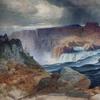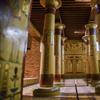PAFA Exhibition on World War I and American Art Features Sargent's Most Haunting Masterpiece
- PHILADELPHIA, Pennsylvania
- /
- October 31, 2016

The Pennsylvania Academy of the Fine Arts (PAFA) presents its ground-breaking exhibition World War I and American Art, on view in the Samuel M.V. Hamilton Building at 128 N. Broad Street in Philadlephia from November 4, 2016 through April 9, 2017.
The first major museum exhibition to revisit this unprecedented global event through the eyes of American artists, World War I and American Art will show how American artists translated their wartime experience, opinions, and perceptions in works that chronicle this transformative moment in American culture. The war’s impact on art and culture was multifaceted, as American artists spoke out against it, participated as soldiers on the battlefield and workers on the home front, designed enlistment posters and camouflage, served as official artists documenting the war, and helped shape postwar society in its wake.

One of the most ambitious projects that PAFA has ever organized, the exhibition’s approximately 160 works by 80 artists encompass a broad variety of stylistic approaches, viewpoints, and experiences through paintings, drawings, sculpture, prints, photographs, posters, and ephemera. A diverse array of both well-known and under-recognized artists is represented including Ivan Albright, George Bellows, Charles Burchfield, John Steuart Curry, Howard Chandler Christy, James Montgomery Flagg, Henry Glintenkamp, Marsden Hartley, Childe Hassam, Carl Hoeckner, George Luks, John Marin, Violet Oakley, Georgia O’Keeffe, Joseph Pennell, Jane Peterson, Horace Pippin, Man Ray, Boardman Robinson, Norman Rockwell, John Singer Sargent, John Sloan, Edward Steichen, and Claggett Wilson.
A small selection of work will also be shown by contemporary artists – including Debra Priestly and recent MacArthur Foundation “genius grant” recipient Mary Reid Kelley – who have confronted World War I’s legacy in their work.
World War I and American Art fully explores the deep and lasting impact of the war, following the chronological arc from prewar tensions to the reverberating after effects in the 1930s, and chronicling its devastating toll on haunted soldiers and ruined cities, relief and hospital workers, women and families.
“World War I and American Art examines a critical moment in history from both the home front and firsthand experience, allowing for images of intense patriotism and outraged dissent to recreate the charged atmosphere leading up to and during the war,” notes David R. Brigham, PAFA President and Acting Museum Director. “Artists both mirrored and participated in these debates, and the images they produced fueled discussions about the United States’ role in the world.”
The exhibition will also demonstrate how the conflict changed American art itself. World War I unfolded as the American art scene was rapidly changing and experiencing a growing range of aesthetic viewpoints, political agendas, exhibition and publication opportunities, and contact with European émigrés. Images made during the war reveal American artists in transition, using more experimental forms including abstraction to capture the apocalyptic tenor of the conflict but also drawing on a straightforward realist manner to make the human experience accessible to their audience.
The exhibition includes numerous high-profile loans, among them John Singer Sargent’s monumental painting, Gassed, from the Imperial War Museums in London. Measuring approximately 20 feet wide by 7 feet tall, the composition depicts the aftermath of a mustard gas attack Sargent witnessed on the Western Front. The painting features a central group of wounded soldiers, depicted nearly life-size, walking toward a field hospital and past the bodies of their dead and injured comrades in arms.
The painting, widely regarded as Sargent’s late masterpiece, conveys the waste and tragedy of conflict and is one of the most disturbing humanistic commentaries on war. Gassed brings together many themes that are essential to the story of the war and this exhibition: differing perspectives on the war and its larger meanings; the camaraderie of soldiers at camp and in the field; the harrowing pain of combat, the dignity of those who sacrifice for their country, and the heartbreaking realities of war, regardless of its justification.
This landmark exhibition is organized by PAFA and curated by Robert Cozzolino, former PAFA senior curator and currently the Patrick and Aimee Butler Curator of Paintings at the Minneapolis Institute of Art; Anne Knutson, an independent scholar and curator; and David Lubin, the Charlotte C. Weber Professor of Art at Wake Forest University. It will be accompanied by an extensive schedule of public programs for all ages, as well as a fully illustrated scholarly catalog.
Although World War I has been characterized as “America’s forgotten war,” Cozzolino notes that “the war’s impact on American art and culture was enormous, for nearly every major American artist of the time produced work that addressed the conflict or contributed in some way to the war effort. It was prevalent in American culture before and after the nation entered the war in 1917.”
“Among the most exciting discoveries made by the curatorial team is the degree to which modernists such as Marin, O’Keeffe, and others were immersed in news and the imagery of the war,” Cozzolino adds. “We are also thrilled to bring the work of little-known artists to light. Clagget Wilson and Carl Hoeckner, for instance, made some of the most haunting images of the war and have not had the chance to be seen in the context of other World War I artwork.”
World War I and American Art is organized around eight themes: Prelude: The Threat of War; Hartley and Hassam: Tenuous Neutrality; Debating the War; Mobilization; Modernists and the War; Battlefields; The Wounded and the Healers; and Celebration and Mourning. Arranged to follow the narrative of the war itself, the exhibition will show how artists chronicled their experiences of the unfolding war as it crept closer to home and then i
nvolved them directly as soldiers, relief workers, political dissenters, and official war artists.
“Exhibits such as this contribute to a deeper understanding of our nation’s history in a way that words could never convey,” said Chris Crane, president and CEO of Exelon, and chairman of the Exelon Foundation. “We’re proud to partner with the Pennsylvania Academy of the Fine Arts to tell the story of the war’s impact on our society and culture through the eyes of artists who bore witness.”
The exhibition will travel to the New York Historical Society in spring 2017, followed by the Frist Center for the Visual Arts in fall 2017. It is accompanied by a fully illustrated scholarly catalog and an extensive schedule of approximately 30 public programs for children and adults of all ages.
Among the events developed in conjunction with the exhibition are lectures and symposia, art-making programs for schools, walking tours, educator workshops, and a co-exhibition of recent art created by veterans. Partners include the American Red Cross, Friends Select, Project Home, Library Company of Philadelphia, Historical Society of Pennsylvania, Thomas Jefferson University, Warrior Writers, International House, Army War College, and others. The symposium is sponsored by the General Representation of the Government of Flanders to the USA. For a complete list of programs, visit www.pafa.org/WWI.
Admission to the exhibition is free every Sunday, courtesy of the Presenting Sponsor, Exelon Foundation and PECO.
















